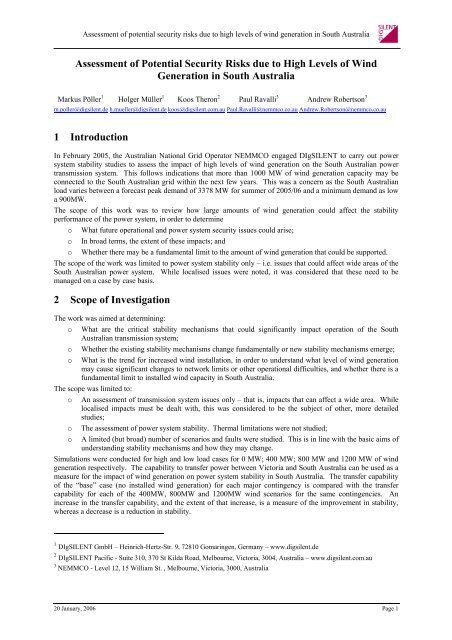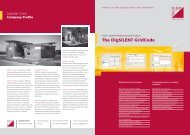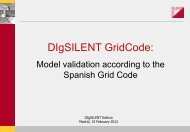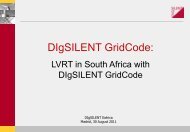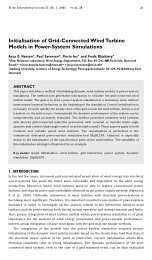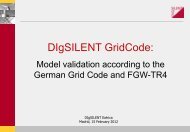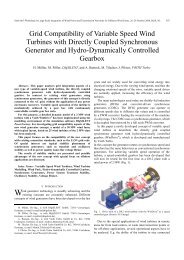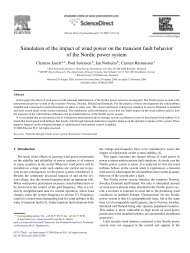Assessment of Potential Security Risks due to High ... - DIgSILENT
Assessment of Potential Security Risks due to High ... - DIgSILENT
Assessment of Potential Security Risks due to High ... - DIgSILENT
You also want an ePaper? Increase the reach of your titles
YUMPU automatically turns print PDFs into web optimized ePapers that Google loves.
<strong>Assessment</strong> <strong>of</strong> potential security risks <strong>due</strong> <strong>to</strong> high levels <strong>of</strong> wind generation in South Australia<br />
<strong>Assessment</strong> <strong>of</strong> <strong>Potential</strong> <strong>Security</strong> <strong>Risks</strong> <strong>due</strong> <strong>to</strong> <strong>High</strong> Levels <strong>of</strong> Wind<br />
Generation in South Australia<br />
Markus Pöller 1 Holger Müller 1 Koos Theron 2 Paul Ravalli 3 Andrew Robertson 3<br />
m.poller@digsilent.de h.mueller@digsilent.de koos@digsilent.com.au Paul.Ravalli@nemmco.co.au Andrew.Robertson@nemmco.co.au<br />
1 Introduction<br />
In February 2005, the Australian National Grid Opera<strong>to</strong>r NEMMCO engaged <strong>DIgSILENT</strong> <strong>to</strong> carry out power<br />
system stability studies <strong>to</strong> assess the impact <strong>of</strong> high levels <strong>of</strong> wind generation on the South Australian power<br />
transmission system. This follows indications that more than 1000 MW <strong>of</strong> wind generation capacity may be<br />
connected <strong>to</strong> the South Australian grid within the next few years. This was a concern as the South Australian<br />
load varies between a forecast peak demand <strong>of</strong> 3378 MW for summer <strong>of</strong> 2005/06 and a minimum demand as low<br />
a 900MW.<br />
The scope <strong>of</strong> this work was <strong>to</strong> review how large amounts <strong>of</strong> wind generation could affect the stability<br />
performance <strong>of</strong> the power system, in order <strong>to</strong> determine<br />
o What future operational and power system security issues could arise;<br />
o In broad terms, the extent <strong>of</strong> these impacts; and<br />
o Whether there may be a fundamental limit <strong>to</strong> the amount <strong>of</strong> wind generation that could be supported.<br />
The scope <strong>of</strong> the work was limited <strong>to</strong> power system stability only – i.e. issues that could affect wide areas <strong>of</strong> the<br />
South Australian power system. While localised issues were noted, it was considered that these need <strong>to</strong> be<br />
managed on a case by case basis.<br />
2 Scope <strong>of</strong> Investigation<br />
The work was aimed at determining:<br />
o What are the critical stability mechanisms that could significantly impact operation <strong>of</strong> the South<br />
Australian transmission system;<br />
o Whether the existing stability mechanisms change fundamentally or new stability mechanisms emerge;<br />
o What is the trend for increased wind installation, in order <strong>to</strong> understand what level <strong>of</strong> wind generation<br />
may cause significant changes <strong>to</strong> network limits or other operational difficulties, and whether there is a<br />
fundamental limit <strong>to</strong> installed wind capacity in South Australia.<br />
The scope was limited <strong>to</strong>:<br />
o An assessment <strong>of</strong> transmission system issues only – that is, impacts that can affect a wide area. While<br />
localised impacts must be dealt with, this was considered <strong>to</strong> be the subject <strong>of</strong> other, more detailed<br />
studies;<br />
o The assessment <strong>of</strong> power system stability. Thermal limitations were not studied;<br />
o A limited (but broad) number <strong>of</strong> scenarios and faults were studied. This is in line with the basic aims <strong>of</strong><br />
understanding stability mechanisms and how they may change.<br />
Simulations were conducted for high and low load cases for 0 MW; 400 MW; 800 MW and 1200 MW <strong>of</strong> wind<br />
generation respectively. The capability <strong>to</strong> transfer power between Vic<strong>to</strong>ria and South Australia can be used as a<br />
measure for the impact <strong>of</strong> wind generation on power system stability in South Australia. The transfer capability<br />
<strong>of</strong> the “base” case (no installed wind generation) for each major contingency is compared with the transfer<br />
capability for each <strong>of</strong> the 400MW, 800MW and 1200MW wind scenarios for the same contingencies. An<br />
increase in the transfer capability, and the extent <strong>of</strong> that increase, is a measure <strong>of</strong> the improvement in stability,<br />
whereas a decrease is a reduction in stability.<br />
1 <strong>DIgSILENT</strong> GmbH – Heinrich-Hertz-Str. 9, 72810 Gomaringen, Germany – www.digsilent.de<br />
2 <strong>DIgSILENT</strong> Pacific - Suite 310, 370 St Kilda Road, Melbourne, Vic<strong>to</strong>ria, 3004, Australia – www.digsilent.com.au<br />
3 NEMMCO - Level 12, 15 William St. , Melbourne, Vic<strong>to</strong>ria, 3000, Australia<br />
20 January, 2006 Page 1
<strong>Assessment</strong> <strong>of</strong> potential security risks <strong>due</strong> <strong>to</strong> high levels <strong>of</strong> wind generation in South Australia<br />
In the development <strong>of</strong> the wind scenarios, it has been assumed that wind generation will displace the existing<br />
scheduled genera<strong>to</strong>rs. That is, when a wind farm is generating power, the most expensive scheduled genera<strong>to</strong>r(s)<br />
in South Australia will reduce their output by an equivalent amount and, if necessary, will disconnect from the<br />
power system. In the scenarios, the installed wind farms are assumed <strong>to</strong> be operating at their maximum<br />
generation. Hence, in the 400MW, 800MW and 1200MW wind scenarios scheduled generation <strong>of</strong> those<br />
amounts are assumed <strong>to</strong> be disconnected from the power system. This approach could only be applied provided:<br />
o There was sufficient scheduled generation <strong>to</strong> be displaced;<br />
o A minimum amount <strong>of</strong> scheduled generation remained on line.<br />
Approximately 400-500MW <strong>of</strong> scheduled generation was assumed <strong>to</strong> remain on line, operating at minimum<br />
load. This takes in<strong>to</strong> account:<br />
o Some genera<strong>to</strong>rs remain on line at minimum load in spite <strong>of</strong> low market costs, <strong>due</strong> <strong>to</strong> the cost <strong>of</strong><br />
restarting the unit; and<br />
o An expectation that some genera<strong>to</strong>rs may stay on line <strong>to</strong> protect their commercial positions under<br />
contract.<br />
While it is more likely that South Australia would be exporting power <strong>to</strong> Vic<strong>to</strong>ria during high wind and access<br />
generation conditions, it was still necessary <strong>to</strong> determine the operating envelope <strong>of</strong> South Australian import<br />
limits.<br />
For the 800MW and 1200MW wind scenarios and low load in South Australia therefore, import in<strong>to</strong> South<br />
Australia is limited or no power import in<strong>to</strong> South Australia will occur. For these cases, therefore, South<br />
Australian demand was increased <strong>to</strong> accommodate the minimum scheduled generation, the installed wind<br />
generation and the imported power – demand was increased in the low load cases <strong>to</strong> approximately 1600MW<br />
and 2000MW, respectively, representing conditions which would be classified as medium, rather than low,<br />
demand.<br />
Murray link was assumed <strong>to</strong> be dispatched at 0MW, though its dynamic impacts were considered.<br />
3 Results <strong>of</strong> Study<br />
3.1 Impact on South Australian Export Capability<br />
Transfer limit (MW)<br />
800<br />
700<br />
600<br />
500<br />
400<br />
300<br />
200<br />
100<br />
0<br />
SA-Vic Transfer Limit<br />
Nominal limit<br />
(300MW)<br />
Thermal limit<br />
(460MW)<br />
0 400 800 1200<br />
Wind Scenario (MW)<br />
Figure 1 - South Australian export transient stability limit<br />
<strong>High</strong> Load<br />
Low Load<br />
During high wind generation in South Australia it is anticipated that power will be exported during most times.<br />
Therefore wind genera<strong>to</strong>r impact on export limits was the first issue <strong>to</strong> be addressed.<br />
20 January, 2006 Page 2
<strong>Assessment</strong> <strong>of</strong> potential security risks <strong>due</strong> <strong>to</strong> high levels <strong>of</strong> wind generation in South Australia<br />
At present, power export between SA and VIC is limited by the thermal limit <strong>of</strong> the SA-VIC interconnec<strong>to</strong>r. A<br />
further possible limit could be <strong>due</strong> <strong>to</strong> transient stability constraints between SA and VIC.<br />
The following contingencies have been assessed:<br />
o Fault and trip <strong>of</strong> the Tailem Bend–South East substation 275kV transmission line; and<br />
o Fault and trip <strong>of</strong> the Moorabool–Heywood–Alcoa Portland 500kV transmission line.<br />
Based on the transient stability analysis, the effect <strong>of</strong> wind generation tends <strong>to</strong> have a beneficial influence on<br />
transient stability constrained export limits, as shown in Figure 1. This is <strong>due</strong> primarily <strong>to</strong> the decoupling<br />
between the mechanical components <strong>of</strong> the genera<strong>to</strong>r and the network resulting in a reduced increase <strong>of</strong> kinetic<br />
energy s<strong>to</strong>red in South Australian synchronous genera<strong>to</strong>rs at fault clearance.<br />
3.2 Impact on South Australian Import Capability<br />
Even if most cases with high wind generation in SA power will be exported <strong>to</strong> VIC, it is necessary <strong>to</strong> analyse the<br />
impact <strong>of</strong> wind generation in SA on voltage stability constraint import limits in order <strong>to</strong> determine the operating<br />
envelope <strong>of</strong> the power system.<br />
The most severe stability effects limiting power import in<strong>to</strong> SA are related <strong>to</strong> short-term and long-term voltage<br />
stability effects.<br />
In most cases, the loss <strong>of</strong> large South Australian power plants is the critical contingency. The resulting increased<br />
power transfer can lead <strong>to</strong> the following effects resulting in a South Australian system collapse:<br />
o Violation <strong>of</strong> static stability limits across the VIC-SA interconnec<strong>to</strong>r right after the genera<strong>to</strong>r outage and<br />
<strong>to</strong> a subsequent system collapse (time frame <strong>of</strong> a few seconds, short-term voltage stability problem)<br />
o Violation <strong>of</strong> static stability limits across the VIC-SA interconnec<strong>to</strong>r in the long-term, when excitation<br />
current limiters limit the maximum reactive power output <strong>of</strong> synchronous genera<strong>to</strong>rs and hence voltage<br />
is reduced.<br />
o Reactive reserve problem in the Adelaide area because the reactive power <strong>of</strong> SVCs, switched shunts<br />
and remaining synchronous genera<strong>to</strong>rs is not sufficient <strong>to</strong> provide the reactive power demand in the<br />
Adelaide area (long-term effect).<br />
Besides loss <strong>of</strong> a large power station in SA, the trip <strong>of</strong> lines importing reactive power from VIC <strong>to</strong> SA can be<br />
critical <strong>to</strong>o.<br />
Transfer limit (MW)<br />
700<br />
600<br />
500<br />
400<br />
300<br />
200<br />
100<br />
0<br />
Vic-SA Transfer Limit<br />
(transient voltage collapse)<br />
0 400 800 1200<br />
Wind Scenario (MW)<br />
Optimistic<br />
Pessimistic<br />
Thermal<br />
limit<br />
Limited by long term<br />
voltage collapse<br />
Figure 2 – Impact on short-term voltage stability constrained import limits (high-load case)<br />
20 January, 2006 Page 3
<strong>Assessment</strong> <strong>of</strong> potential security risks <strong>due</strong> <strong>to</strong> high levels <strong>of</strong> wind generation in South Australia<br />
3.2.1 Impact on Short-Term Voltage Stability Limits<br />
The following disturbances were analysed for analysing short-term voltage stability effects:<br />
o Trip <strong>of</strong> a Northern Power Station genera<strong>to</strong>r (near Davenport) (operating at maximum output prior <strong>to</strong> the<br />
trip).<br />
o Fault and trip on the Davenport <strong>to</strong> Northern Power Station line feeding the Northern Power Station<br />
genera<strong>to</strong>r<br />
Figure 2 shows that there is a trend <strong>to</strong>wards lower import limits with increasing amount <strong>of</strong> wind generation in<br />
South Australia. In the 1200MW case, the long-term voltage stability limit is reached without contingency before<br />
any short-term voltage stability problem can be observed <strong>due</strong> <strong>to</strong> the described reactive power deficit in SA.<br />
The different results for “Optimistic” and “Pessimistic” refer <strong>to</strong> optimistic and pessimistic assumptions with<br />
regard <strong>to</strong> wind genera<strong>to</strong>r behaviour and local problems that have been found in sub-transmission networks<br />
surrounding the wind farms leading <strong>to</strong> the disconnection <strong>of</strong> wind-farms following the initial contingency.<br />
The “optimistic” results assume that all wind genera<strong>to</strong>rs behave as designed and that the sub-transmission<br />
networks will be properly designed.<br />
“Pessimistic” results were obtained using preliminary modelling data <strong>of</strong> the subtransmission networks and windfarms.<br />
Hence, with regard <strong>to</strong> “feasibility” the “optimistic” results are relevant. “Pessimistic” results especially highlight<br />
the relevance <strong>of</strong> “low voltage ride-through capability” <strong>of</strong> all wind farms under all voltage variations that can<br />
occur if the system is operated close <strong>to</strong> voltage stability limits.<br />
3.2.2 Impact on Long-Term Voltage Stability Limits<br />
Transfer Limit MW<br />
600,0<br />
500,0<br />
400,0<br />
300,0<br />
200,0<br />
100,0<br />
0,0<br />
VIC-SA Transfer Limit (Long-Term Voltage Stability, <strong>High</strong>-Load)<br />
505,0<br />
511,0<br />
20 January, 2006 Page 4<br />
325,0<br />
Thermal<br />
Limit<br />
206,0<br />
0,0 400,0 800,0 1200,0<br />
Wind Generation in SA in MW<br />
Figure 3: Impact on Long-Term Voltage Stability Constrained Import Limits<br />
In the long term, reactive power output <strong>of</strong> synchronous genera<strong>to</strong>rs is mainly limited by excitation current limiters<br />
<strong>of</strong> synchronous genera<strong>to</strong>rs. Hence, reactive power output <strong>of</strong> synchronous genera<strong>to</strong>rs is substantially lower in the<br />
long-term than in the short-term, which can drive the system in<strong>to</strong> a long-term voltage collapse, even if it survives<br />
a contingency in the short-term. On the other hand, the system is supported by switchable shunts providing<br />
additional reactive power, which is not available in the short-term. Hence, both effects, long-term and short-term<br />
effects have <strong>to</strong> be analysed.<br />
Long term voltage stability was analysed using PV-curves. It was assumed that no wind genera<strong>to</strong>r trips <strong>of</strong>f and<br />
that a power outage is entirely compensated by genera<strong>to</strong>rs outside SA. (ie.: across Heywood)<br />
Long term voltage stability was investigated for the following disturbances:
<strong>Assessment</strong> <strong>of</strong> potential security risks <strong>due</strong> <strong>to</strong> high levels <strong>of</strong> wind generation in South Australia<br />
o Trip <strong>of</strong> a Northern Power Station genera<strong>to</strong>r (near Davenport) (operating at maximum output prior <strong>to</strong> the<br />
trip).<br />
o Trip <strong>of</strong> a Torrens B Power Station genera<strong>to</strong>r (near Adelaide) (operating at maximum output prior <strong>to</strong> the<br />
trip).<br />
o Trip <strong>of</strong> a Tailem Bend <strong>to</strong> South East Substation 275kV transmission line in South Australia;<br />
o Trip <strong>of</strong> a Moorabool-Heywood-Alcoa Portland 500kV line in Vic<strong>to</strong>ria.<br />
The lowest transfer limit determined for all <strong>of</strong> these disturbances for each <strong>of</strong> the scenarios is shown in Figure 3.<br />
There are three important features <strong>of</strong> the trend shown:<br />
o There is a steady reduction in transfer capability as more wind generation operates;<br />
o The critical contingency changes from the current critical contingency <strong>of</strong> loss <strong>of</strong> a Northern Power<br />
Station genera<strong>to</strong>r <strong>to</strong> transmission related contingencies for higher levels <strong>of</strong> wind generation; and<br />
o Under the high demand and 1200MW wind scenario the stability mechanism changes from being<br />
managed through interconnec<strong>to</strong>r transfers <strong>to</strong> being a voltage collapse in the Adelaide metropolitan area.<br />
These effects are <strong>due</strong> <strong>to</strong> the steady depletion <strong>of</strong> reactive power reserves available <strong>to</strong> the 275kV network. The<br />
displacement <strong>of</strong> scheduled genera<strong>to</strong>rs mentioned above results in the removal <strong>of</strong> the static and dynamic reactive<br />
support provided by those genera<strong>to</strong>rs. Reactive power reserves and the ability <strong>of</strong> the system <strong>to</strong> regulate the<br />
voltage are reduced because <strong>of</strong> the limited ability <strong>of</strong> genera<strong>to</strong>rs embedded in sub-transmission systems <strong>to</strong> provide<br />
reactive power for supporting the voltage at the transmission level.<br />
3.3 Impact on South Australian Frequency when Suddenly Islanded<br />
The loss <strong>of</strong> the Vic-SA interconnec<strong>to</strong>r is a credible contingency event under some conditions. This occurs, for<br />
example, during s<strong>to</strong>rm activity in the vicinity <strong>of</strong> the interconnec<strong>to</strong>r, or when there is a critical line out <strong>of</strong> service<br />
(as a forced or planned outage). During these times, if the South Australian import is greater that 250MW, the<br />
transfer is reduced <strong>to</strong> 250MW. Should the interconnecter be tripped under these conditions, the frequency in the<br />
South Australian power system will drop rapidly.<br />
The inertia in South Australia is significantly reduced under high wind generation conditions. This will have an<br />
influence on the rate <strong>of</strong> change <strong>of</strong> power system frequency for the loss <strong>of</strong> the interconnec<strong>to</strong>r. An analysis has<br />
been carried out <strong>to</strong> determine the impact on frequency rates <strong>of</strong> change under the various wind scenarios,<br />
compared with the base (no wind) case. The results are shown in Table 1.<br />
Table 1 - Frequency rates <strong>of</strong> change in South Australia for loss <strong>of</strong> the Vic-SA interconnec<strong>to</strong>r<br />
Scenario<br />
<strong>High</strong> Load<br />
Low Load<br />
Base<br />
(0 MW) 400 MW 800 MW 1200 MW<br />
Rate <strong>of</strong> frequency<br />
0.30 0.34 0.38 0.42<br />
decline (Hz/sec)<br />
Increased rate<br />
(compared <strong>to</strong> Base)<br />
13% 27% 40%<br />
Rate <strong>of</strong> frequency<br />
0.54 0.70 0.74 0.84<br />
decline (Hz/sec)<br />
Increased rate<br />
(compared <strong>to</strong> Base)<br />
30% 37% 55%<br />
There is no specific comment that can be made at this stage in terms <strong>of</strong> any impact in South Australia <strong>due</strong> <strong>to</strong> the<br />
increased frequency rate <strong>of</strong> change, except that this effect would need <strong>to</strong> be taken in<strong>to</strong> account in any review <strong>of</strong><br />
under-frequency load shedding arrangements for South Australia.<br />
3.4 Impact on Other NEM Inter-connec<strong>to</strong>rs<br />
A review <strong>of</strong> the effect on several other inter-connec<strong>to</strong>rs has also been undertaken, <strong>to</strong> determine whether there<br />
may be significant issues for other NEM regions.<br />
20 January, 2006 Page 5
<strong>Assessment</strong> <strong>of</strong> potential security risks <strong>due</strong> <strong>to</strong> high levels <strong>of</strong> wind generation in South Australia<br />
3.4.1 Impact for faults outside <strong>of</strong> South Australia<br />
Several inter-connec<strong>to</strong>rs have constraint equations for transient stability limits, with explicit terms associated<br />
with South Australian inertia. These are the Vic-Snowy interconnec<strong>to</strong>r and the NSW-Snowy interconnec<strong>to</strong>r.<br />
According <strong>to</strong> the constraint equations, a reduction in the South Australian inertia will reduce the transient<br />
stability limits <strong>of</strong> both <strong>of</strong> these inter-connec<strong>to</strong>rs, although the Vic-Snowy interconnec<strong>to</strong>r shows a higher<br />
sensitivity. The results showed that the impact on the Vic-Snowy is a slight reduction for increased wind<br />
generation, as expected from the constraint equation, and relatively small (around 60-70MW).<br />
3.4.2 Impact on inter-area oscilla<strong>to</strong>ry modes<br />
The least damped NEM inter-area oscilla<strong>to</strong>ry mode is the one associated with the Queensland–New South Wales<br />
interconnec<strong>to</strong>r (QNI). This mode has been assessed using eigenvalue analysis, and the contingency in this case<br />
was the loss <strong>of</strong> one <strong>of</strong> the parallel Queensland–New South Wales lines.<br />
The damping criterion for inter-area oscilla<strong>to</strong>ry stability requires that oscillations be damped with a 5 second<br />
halving time [1].<br />
The results show that under high load conditions there may be some reduction in damping, although relatively<br />
small (less than 0.01nepers/s). In order <strong>to</strong> put this in<strong>to</strong> perspective, the Inter-Regional Planning Committee<br />
guidelines for material inter-network impacts for network augmentations [2] nominates that a material impact is<br />
a shift <strong>of</strong> 0.01nepers/s or more <strong>to</strong>wards the unstable half-plane (<strong>to</strong> the right <strong>of</strong> the y-axis). While the guidelines<br />
apply <strong>to</strong> network augmentations only, it indicates that the installation and operation <strong>of</strong> 1200MW <strong>of</strong> wind<br />
generation in South Australia would not be considered as a “material impact”. Under light load conditions, there<br />
is a significant improvement <strong>to</strong> the QNI mode.<br />
4 Conclusion<br />
The report analysed the impact <strong>of</strong> wind generation in South Australia on different stability effects. The impact on<br />
the following stability effects that have been analysed are:<br />
1. Transient stability constrained export limits SA->VIC<br />
2. Short-term voltage stability constrained import limits SA


